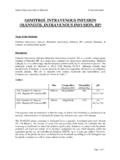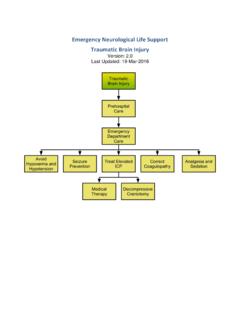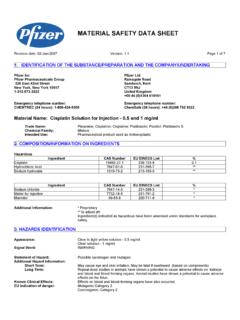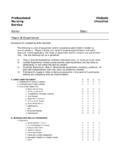Transcription of DBL™ OCTREOTIDE INJECTION - Medsafe
1 Data Sheet New Zealand Version 1 DBL OCTREOTIDE INJECTION Name of medicine OCTREOTIDE acetate Presentation Each 1 mL vial of DBL OCTREOTIDE INJECTION is a clear colourless solution, containing mg, mg or mg of OCTREOTIDE acetate with the excipients, glacial acetic acid, sodium acetate trihydrate, sodium chloride and water for injections. DBL OCTREOTIDE INJECTION contains OCTREOTIDE acetate, a synthetic octapeptide analogue of Somatostatin H-D-Phe-Cys-Phe-D-Trp-Lys-Thr-Cys-L-thre oninol CAS number: 79517-01-4. ( OCTREOTIDE acetate) MW: (free peptide) Uses Actions Pharmacodynamics Pharmacotherapeutic group: Antigrowth hormone (ATC code H01CB02) OCTREOTIDE is a synthetic octapeptide derivative of naturally occurring somatostatin with similar pharmacological effects, but with a considerably prolonged duration of action.
2 It inhibits pathologically increased secretion of growth hormone (GH) and of peptides and serotonin produced within the GEP endocrine system. In animals, OCTREOTIDE is a more potent inhibitor of GH, glucagon and insulin release than somatostatin is, with greater selectivity for GH- and glucagon-suppression. In healthy subjects OCTREOTIDE has been shown to inhibit: Release of growth hormone (GH) stimulated by arginine, exercise and insulin-induced hypoglycaemia Postprandial release of insulin, glucagon, gastrin, other peptides of the gastro-entero-pancreatic (GEP) endocrine system, and arginine-stimulated release of insulin and glucagon Thyrotropin releasing hormone (TRH) stimulated release of thyroid stimulating hormone (TSH) Unlike somatostatin, OCTREOTIDE inhibits GH secretion preferentially over insulin and its administration is not followed by rebound hypersecretion of hormones ( GH in patients with acromegaly).
3 In acromegalic patients OCTREOTIDE lowers plasma level of GH and IGF-1. A GH reduction by 50% or more occurs in up to 90% of patients, and a reduction of serum GH to <5 ng/mL can be achieved in about half of the cases. In most patients OCTREOTIDE markedly reduces the clinical symptoms of the disease, such as headache, skin and soft tissue swelling, hyperhidrosis, arthralgia and paraesthesia. In patients with a large pituitary adenoma, OCTREOTIDE treatment may result in some shrinkage of the tumour mass. In patients with functional tumours of the GEP endocrine system, OCTREOTIDE , because of its diverse endocrine effects, modifies a number of clinical features.
4 Clinical improvement and symptomatic benefit occur in patients who still have symptoms related to their tumours despite previous therapies, which may include surgery, hepatic artery embolisation and various chemotherapies, streptozotocin and 5-fluorouracil. OCTREOTIDE s effects in the different tumour types are as follows: Carcinoid tumours: Administration of OCTREOTIDE may result in improvement of symptoms, particularly of flush and diarrhoea. In many cases this is accompanied by a fall in plasma serotonin and reduced urinary excretion of 5-hydroxyindole acetic acid.
5 Data Sheet New Zealand Version 2 Vasoactive intestinal peptide secreting tumours (VIPomas): The biochemical characteristic of these tumours is overproduction of vasoactive intestinal peptide (VIP). In most cases, administration of OCTREOTIDE results in alleviation of the severe secretory diarrhoea typical of the condition, with consequent improvement in quality of life. This is accompanied by an improvement in associated electrolyte abnormalities, hypokalaemia, enabling enteral and parenteral fluid and electrolyte supplementation to be withdrawn.
6 In some patients, computer tomography scanning suggests a slowing or arrest of progression of the tumour, or even tumour shrinkage, particularly of hepatic metastases. Clinical improvement is usually accompanied by a reduction in plasma VIP levels, which may fall into the normal reference range. Glucagonomas: Administration of OCTREOTIDE results in most cases in substantial improvement of the necrolytic migratory rash which is characteristic of the condition. The effect of OCTREOTIDE on the state of mild diabetes mellitus which frequently occurs is not marked and, in general, does not result in a reduction of requirements for insulin or oral hypoglycaemic agents.
7 OCTREOTIDE produces improvement of diarrhoea, and hence weight gain, in those patients affected. Although administration of OCTREOTIDE often leads to an immediate reduction in plasma glucagon levels, this decrease is generally not maintained over a prolonged period of administration, despite continued symptomatic improvement. Gastri nomas/Zollinger-Ellis syndrome: Although therapy with proton pump inhibitors or H2-receptor blocking agents controls the recurrent peptic ulceration which results from chronic gastrin-stimulated hypersecretion of gastric acid, such control may be incomplete.
8 Diarrhoea may also be a prominent symptom not alleviated by this therapy. OCTREOTIDE alone or in conjunction with proton pump inhibitors or H2-receptor antagonists may reduce gastric acid hypersecretion and improve symptoms, including diarrhoea. Other symptoms possibly due to peptide production by the tumour, flush, may also be relieved. Plasma gastrin levels fall in some patients. Insulinomas: Administration of OCTREOTIDE produces a fall in circulating immunoreactive insulin, which may, however, be of short duration (about 2 hours). In patients with operable tumours OCTREOTIDE may help to restore and maintain normoglycaemia pre-operatively.
9 In patients with inoperable benign or malignant tumours, glycaemic control may be improved without concomitant sustained reduction in circulating insulin levels. GRFomas: These rare tumours are characterised by production of GH releasing factor (GRF) alone or in conjunction with other active peptides. OCTREOTIDE produces improvement in the features and symptoms of the resultant acromegaly. This is probably due to inhibition of GRF and GH secretion, and a reduction in pituitary enlargement may follow. In patients with acquired immune deficiency syndrome (AIDS)-related refractory diarrhoea, OCTREOTIDE produces partial or complete control of stool output in about one-third of patients with diarrhoea unresponsive to conventional anti-infective and/or anti-diarrhoeal agents.
10 For patients undergoing pancreatic surgery, the peri- and post-operative administration of OCTREOTIDE reduces the incidence of typical post-operative complications ( pancreatic fistula, abscess and subsequent sepsis, post-operative acute pancreatitis). In patients presenting with bleeding gastro-oesophageal varices due to underlying cirrhosis, OCTREOTIDE administration in combination with specific treatment ( sclerotherapy) is associated with better control of bleeding and early re-bleeding, reduced transfusion requirements, and improved 5-day survival. While the precise mode of action of OCTREOTIDE is not fully elucidated, it is postulated that OCTREOTIDE reduces splanchnic blood flow through inhibition of vaso-active hormones ( VIP, glucagon).
















